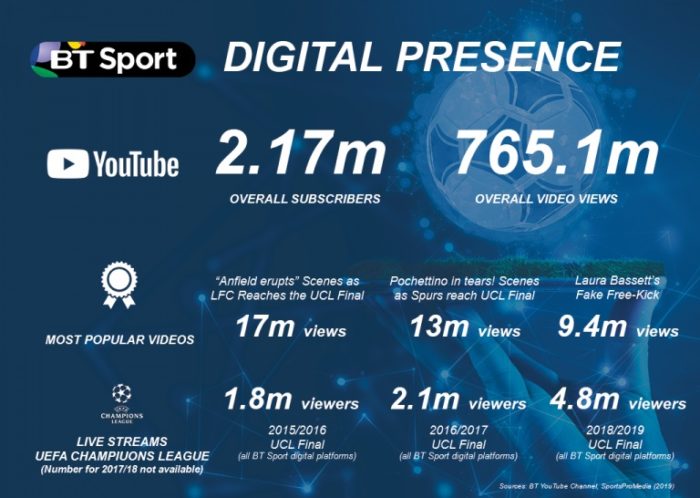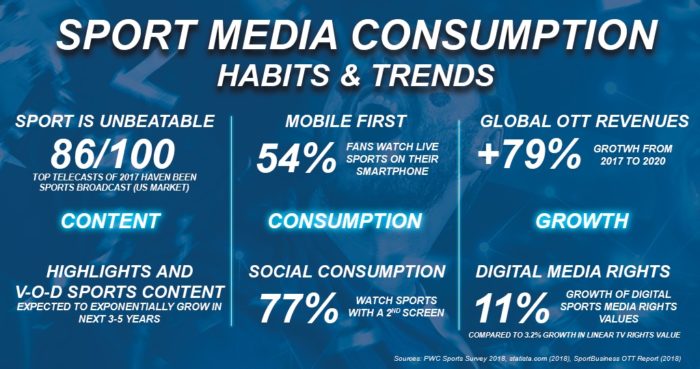
Will OTT kill linear TV broadcasting?
share on
This post is sponsored by Lagardere Sports.
The end for linear TV broadcasters is near – the future belongs to the OTT players: this is currently the topic of discussion among broadcasters, rights holders and agencies.
But does this really mean the end for linear TV broadcasters? There is no doubt that switching on the TV and just flicking through programmes belongs to the past – the future is digital, and mobile content consumption is the real deal.
This does not necessarily mean that linear TV broadcasters need to close their businesses – in fact, it is hard to tell how we will consume sports in 10 years from now, the only thing which is certain is it will not be on any linear TV channel.
Content is not only king – it reigns over the channel
Let’s face the truth: What determines your choice on which platform you usually find yourself consuming sports content is the content itself.

The distribution and display technologies are just a transmitter of such content, but still, everybody – and therefore every broadcaster – has the chance to stay relevant even in the youngest target groups who grow up without having watched linear TV once.
Speaking with broadcasters these days, you get the feeling that some of them are close to giving up. But there are great examples of how you can still reach huge numbers even though you are primarily a linear broadcaster.
UK BT Sport, with its YouTube broadcasts, is showcasing one way on how you can be the same company with the same content and the same strong reach: just use the technology – it is already there.
The point is: whether you are a social media network, a traditional TV channel or a single influencer – you will only attract an audience if you provide engaging content which is displayed in a way that matches the channel and the consumption habits of your target group – once this is done the advertising industry will find its way to you.
So, instead of arguing about how to get people back onto linear TV, linear TV operators should ask themselves what formats and distribution systems they should go for in order to stay relevant in the future.
Of course, it is easy to judge now after we have seen the first part of the digital transformation, but the fact is there is actually no difference between a FOX, a DAZN, a twitter; they show live sports content, the only difference is where to find them and how they position themselves.
How will we consume sports content in 10 years from now?
For sure, the business models behind the companies mentioned above are very different, but their intention is the same: acquire the rights to sport events to attract people/users to join their platforms and become commercialised assets.
But can anybody say what’s the right strategy to be a main sports media player in 10 years from now? Is it really live sports? Is it only VOD? Is it a social network where audio-visual content is just a side-dish? Will the rights holders themselves become media platforms?
There has never been a more interesting time in the sports media world, where we see so many different approaches: the heavy investment of DAZN to become a “Netflix of sport” with seemingly never empty pockets; the rise of rights holders OTTs following the strong American-led movement of the NFL, NBA and UFC; the sports vertical approach Discovery is seeming to realise in golf and cycling; the investments of Google, Apple, Facebook and Amazon; Disney’s bundle approach delivering sports and non-sports premium content and attacking the likes of Netflix and co; the VOD-non-match related platforms such as Copa90, and many more to come.

Looking at the US, we have already witnessed one traditional sports media brand on its way from the linear TV world to the OTT world: ESPN is currently balancing between staying a strong traditional TV brand and establishing a unique offering for all digital natives with its ESPN+ offer. The industry giant is slowly getting back on track with a positive development in the brand reception among US citizens according to internal ESPN research results.
In a short lead time, ESPN has managed to develop a strong digital footprint with the OTT offer which is two million-plus subscribers ahead of the company’s plans. Even though ESPN+ will not replace ESPN – it might do in the long run – but if it happens, then ESPN will be well-placed in the world of digital sport content offerings, using social networks such as Twitter and YouTube to boost its reach: for example, the “on the clock” live coverage of the NFL draft was exclusively produced for the digital audience with 5.5 million viewers – a very positive showcase for such an approach.
Only the brave will survive
Exploring the sports media landscape, there are so many creative approaches on attracting audiences, and traditional broadcasters with their talent and vast experience can create many valuable products to take back pole position in the race for an audience – they just need to take a risk and look ahead – and certainly not back, praising the “good old times”.
The model should be: Use existing digital infrastructures, be innovators on the content side, and create products which add value for the viewer and the advertising industry.
These traditional linear broadcasters have amazed generation after generation sitting in front of the TV by exciting them over live sports events and shows – and they should continue doing exactly that, but just on a different medium, in a different format targeted to a younger age group.
The writer is Erik Steinmeyer, senior manager of media, Lagardere Sports.
share on
Free newsletter
Get the daily lowdown on Asia's top marketing stories.
We break down the big and messy topics of the day so you're updated on the most important developments in Asia's marketing development – for free.
subscribe now open in new window
